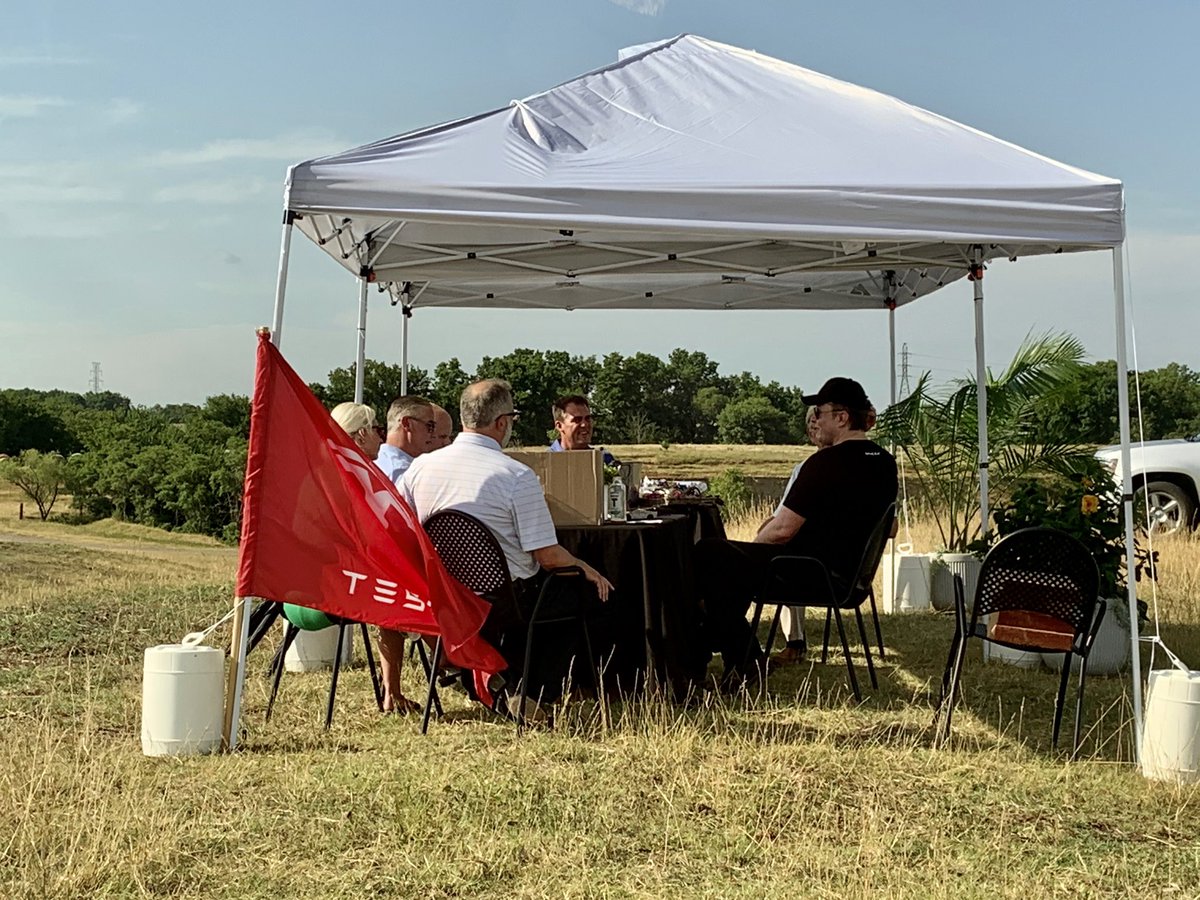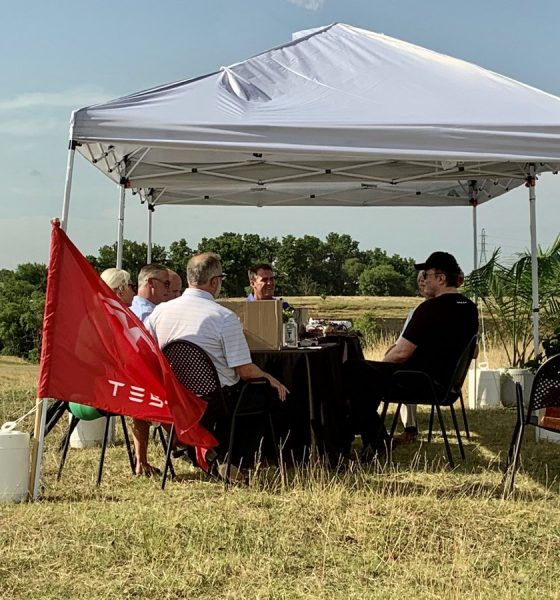

News
Elon Musk accepts Oklahoma Gov. invite, visits site of proposed Tesla factory in Tulsa
On Friday afternoon, Tesla CEO Elon Musk and Director of Policy and Government Affairs Craig Hulse landed in Tulsa, OK, for a meeting with local officials. Musk’s trip comes amidst Tesla’s highly anticipated announcement about the site of the Cybertruck Gigafactory, the electric car maker’s upcoming manufacturing plant for its unique all-electric pickup.
Musk and Hulse were welcomed by Gov. Kevin Stitt and Secretary of Commerce Sean Kouplen, as well as the property owner of a plot of land that the city is offering to the electric car maker. Images shared by the Gov. Stitt show Musk and local officials conversing in the middle of a massive plot of land. The meetup seemed to be private and simple, though the governor highlighted that he still believes that Tulsa is the perfect place for Tesla’s next vehicle production plant.
In a statement to local news agency Tulsa World, Kouplen noted that the meeting involved showing Elon Musk the plan for the potential Cybertruck Gigafactory site, as well as discussions about the location’s utilities and access to downtown. “To maximize our time together, we had set up a tent, table, chairs, some snacks, and water on the site. You can see downtown from the site, we are up high on a hill, it is really a beautiful day. So we’re basically just having our little over an hour conversation out there in the middle of the field,” he said.
“The site is very important to Elon. He likes to get a feel for it. He really goes based upon his kind of personal feeling. So that was a big part of it, just letting him experience the drive from downtown to the site. We showed him the site plan, what it would looked like on the site. We obviously talked about things like utility access, and water and natural gas access — all the kind of the basics around the site and really just kind of tried to visualize what a Tesla plant would look like on that particularly piece of land.”
Musk, for his part, seemed to have appreciated the meeting, thanking officials for hosting his visit. Musk’s recent visit, as well as his succeeding statements, suggest that Tulsa is still on the running as a potential site for the Cybertruck Gigafactory. This is a small victory for the city, especially considering that Tulsa has launched a series of initiatives and social media campaigns to encourage Musk to consider and select the city for its next vehicle production plant.
Kouplen, for his part, noted that even if Tulsa loses to Austin this time around, it does not mean that Tesla will never establish a presence in the city. This is especially notable considering that Tesla would likely need additional sites for upcoming projects like the Semi’s production ramp and the expansion of its energy products. Thus, for Tulsa, there will be no regrets, regardless of which site Tesla selects for the Cybertruck factory.
“This won’t be the last factory they build or the last investment they make. We’re building a relationship with Tesla that will continue regardless of what happens this time,” Kouplen said.

News
Tesla starts showing how FSD will change lives in Europe
Local officials tested the system on narrow country roads and were impressed by FSD’s smooth, human-like driving, with some calling the service a game-changer for everyday life in areas that are far from urban centers.

Tesla has launched Europe’s first public shuttle service using Full Self-Driving (Supervised) in the rural Eifelkreis Bitburg-Prüm region of Germany, demonstrating how the technology can restore independence and mobility for people who struggle with limited transport options.
Local officials tested the system on narrow country roads and were impressed by FSD’s smooth, human-like driving, with some calling the service a game-changer for everyday life in areas that are far from urban centers.
Officials see real impact on rural residents
Arzfeld Mayor Johannes Kuhl and District Administrator Andreas Kruppert personally tested the Tesla shuttle service. This allowed them to see just how well FSD navigated winding lanes and rural roads confidently. Kruppert said, “Autonomous driving sounds like science fiction to many, but we simply see here that it works totally well in rural regions too.” Kuhl, for his part, also noted that FSD “feels like a very experienced driver.”
The pilot complements the area’s “Citizen Bus” program, which provides on-demand rides for elderly residents who can no longer drive themselves. Tesla Europe shared a video of a demonstration of the service, highlighting how FSD gives people their freedom back, even in places where public transport is not as prevalent.
What the Ministry for Economic Affairs and Transport says
Rhineland-Palatinate’s Minister Daniela Schmitt supported the project, praising the collaboration that made this “first of its kind in Europe” possible. As per the ministry, the rural rollout for the service shows FSD’s potential beyond major cities, and it delivers tangible benefits like grocery runs, doctor visits, and social connections for isolated residents.
“Reliable and flexible mobility is especially vital in rural areas. With the launch of a shuttle service using self-driving vehicles (FSD supervised) by Tesla in the Eifelkreis Bitburg-Prüm, an innovative pilot project is now getting underway that complements local community bus services. It is the first project of its kind in Europe.
“The result is a real gain for rural mobility: greater accessibility, more flexibility and tangible benefits for everyday life. A strong signal for innovation, cooperation and future-oriented mobility beyond urban centers,” the ministry wrote in a LinkedIn post.
News
Tesla China quietly posts Robotaxi-related job listing
Tesla China is currently seeking a Low Voltage Electrical Engineer to work on circuit board design for the company’s autonomous vehicles.

Tesla has posted a new job listing in Shanghai explicitly tied to its Robotaxi program, fueling speculation that the company is preparing to launch its dedicated autonomous ride-hailing service in China.
As noted in the listing, Tesla China is currently seeking a Low Voltage Electrical Engineer to work on circuit board design for the company’s autonomous vehicles.
Robotaxi-specific role
The listing, which was shared on social media platform X by industry watcher @tslaming, suggested that Tesla China is looking to fill the role urgently. The job listing itself specifically mentions that the person hired for the role will be working on the Low Voltage Hardware team, which would design the circuit boards that would serve as the nervous system of the Robotaxi.
Key tasks for the role, as indicated in the job listing, include collaboration with PCB layout, firmware, mechanical, program management, and validation teams, among other responsibilities. The role is based in Shanghai.
China Robotaxi launch
China represents a massive potential market for robotaxis, with its dense urban centers and supportive policies in select cities. Tesla has limited permission to roll out FSD in the country, though despite this, its vehicles have been hailed as among the best in the market when it comes to autonomous features. So far, at least, it appears that China supports Tesla’s FSD and Robotaxi rollout.
This was hinted at in November, when Tesla brought the Cybercab to the 8th China International Import Expo (CIIE) in Shanghai, marking the first time that the autonomous two-seater was brought to the Asia-Pacific region. The vehicle, despite not having a release date in China, received a significant amount of interest among the event’s attendees.
Elon Musk
Elon Musk and Tesla AI Director share insights after empty driver seat Robotaxi rides
The executives’ unoccupied tests hint at the rapid progress of Tesla’s unsupervised Robotaxi efforts.

Tesla CEO Elon Musk and AI Director Ashok Elluswamy celebrated Christmas Eve by sharing personal experiences with Robotaxi vehicles that had no safety monitor or occupant in the driver’s seat. Musk described the system’s “perfect driving” around Austin, while Elluswamy posted video from the back seat, calling it “an amazing experience.”
The executives’ unoccupied tests hint at the rapid progress of Tesla’s unsupervised Robotaxi efforts.
Elon and Ashok’s firsthand Robotaxi insights
Prior to Musk and the Tesla AI Director’s posts, sightings of unmanned Teslas navigating public roads were widely shared on social media. One such vehicle was spotted in Austin, Texas, which Elon Musk acknowleged by stating that “Testing is underway with no occupants in the car.”
Based on his Christmas Eve post, Musk seemed to have tested an unmanned Tesla himself. “A Tesla with no safety monitor in the car and me sitting in the passenger seat took me all around Austin on Sunday with perfect driving,” Musk wrote in his post.
Elluswamy responded with a 2-minute video showing himself in the rear of an unmanned Tesla. The video featured the vehicle’s empty front seats, as well as its smooth handling through real-world traffic. He captioned his video with the words, “It’s an amazing experience!”
Towards Unsupervised operations
During an xAI Hackathon earlier this month, Elon Musk mentioned that Tesla owed be removing Safety Monitors from its Robotaxis in Austin in just three weeks. “Unsupervised is pretty much solved at this point. So there will be Tesla Robotaxis operating in Austin with no one in them. Not even anyone in the passenger seat in about three weeks,” he said. Musk echoed similar estimates at the 2025 Annual Shareholder Meeting and the Q3 2025 earnings call.
Considering the insights that were posted Musk and Elluswamy, it does appear that Tesla is working hard towards operating its Robotaxis with no safety monitors. This is quite impressive considering that the service was launched just earlier this year.








